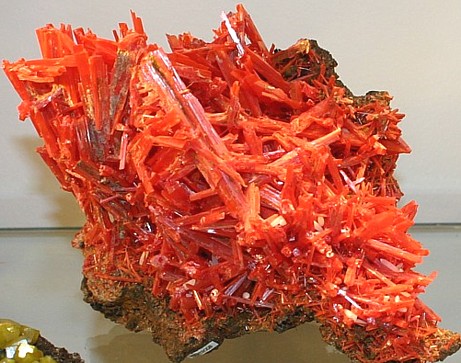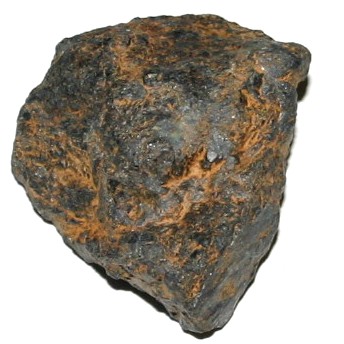Chromium, which is only
very rarely found in its metallic state in nature, is produced by the
reduction of its ores by carbon in the electric furnace, or by the Thermite
displacement process using Aluminum. It is a brilliant white metal, having a
specific gravity of about 6, and melting at about 2,000 C. It possesses the
properties of imparting to iron and steel a high degree of hardness and
tenacity, and for that reason has long been of great industrial importance.
For this purpose an alloy of iron and chromium (ferro-chrome, produced in
the electric furnace), is commonly used; it is cheaper to make, melts at a
lower temperature, and is consequently better under control than the pure
metal. The compounds of chromium are also of considerable industrial
importance, and are used as paint pigments and in various industries, such
as dyeing, tanning, printing and photography. Chromite is also used in the
manufacture of refractory bricks for open-hearth steel furnace linings.
Minor chromium minerals include Crocoite, uvarovite garnet, picotite,
chromium-diopside, and Kaemmerite (a chromium rich Clinochlore).
Crocoite is
a lead chromate formed by secondary processes which is well characterized by
its hyacinth-red color. Kaemmererite is a pink to red colored variety of
Clinochlore, and uvarovite is a chromium bearing green colored garnet.
Chromium is used as a steel-hardening metal. It gives to steel a superior
hardness and if added in the proper proportion does not produce brittleness.
Chromium steel is used in the manufacture of those parts of crushing
machinery (rock crusher-jaws, etc.) that are subject to severe abrasion.
Together with nickel, chromium is an important part of nichrome, the metal
used for electric heating elements used in hair dryers, electric ovens,
soldering irons, toasters, and space heating. Stainless steel containing
from 12 to 15 percent chromium is used in the manufacture of stainless steel
cutlery, cookware, plumbing hardware, surgical instruments, major
appliances, industrial equipment and as an automotive and aerospace
structural alloy and construction material in large buildings. Storage tanks
and tankers used to transport certain chemicals or food products are often
made of stainless steel, because of its corrosion resistance and
antibacterial properties. Stainless steel is also used in commercial
kitchens and food processing plants, as it can be steam-cleaned and
sterilized and does not need paint or other surface finishes. Stainless
steel is used for some types of jewelry and watches. It can be re-finished
by any jeweler and will not oxidize or turn black. Chromium is also plated
onto steel for beauty and to protect it from rust.
The mineral chromite is made into bricks that are used as linings for metallurgical furnaces. Various red, orange and green pigments and dyes are made from chromium compounds. Chromium is used for the preparation of various salts, among which the bichromate of potassium is most important. Chromium compounds produce a fine green color in both borax and microcosmic beads. The chief source of chromium is chromite (chrome iron ore), an oxide of iron and chromium. This mineral is a common constituent of basic igneous rocks, such as olivine gabbro, peridotite, and pyroxenite, in which it occurs as disseminated grains, as ill-defined streaks. It is segregated from the melt as a whole during the magmatic cooling process and forms pods and irregular masses. Chromite in large masses has been shown to represent a purely magmatic separation in peridotite magmas. Vogt showed that the succession in the Norwegian deposits was chromite, olivine, and soda-lime feldspar, and in all cases the chromite appears to be the earliest consolidated constituent. Chromite is a mineral of the spinel group and usually admixed with other spinel molecules, is an almost constant accessory of peridotites and of the serpentines derived from them and is often found in them, as accumulations large enough to be mined. It is commonly associated with the minerals olivine, magnetite, serpentine, Uvarovite, Kaemmererite (Chromium rich Clinochlore) and corundum. Peridotite and pyroxenite alter readily to serpentine, and much chromic iron ore is derived chromite deposits in serpentine. It is noteworthy that during the weathering of peridotite and serpentines, only a few chromium silicates are formed, while nickel silicates often develop. A little chromiferous green fuchsite mica (mariposite), also uvarovite or chrome garnet, as well as Kaemmererite, a chloritic chromium mineral, in places accompany the chromite. Copper ore minerals, especially chalcopyrite, are occasionally found with the chromite. The reddish niccolite has been found in serpentines and peridotites at Malaga, Spain. Chromite alters very slowly, and when serpentine bodies are weathered it may collect in gravel deposits or placers. The principal chromite producing countries in order of importance are New Caledonia, Zimbabwe, Russia, Greece and Turkey.
ZIMBABWE: Chromite is found at many localities in Southern Zimbabwe, and is mined extensively at Selukwe, where it occurs in the form of numerous lenticular masses in a matrix of talc-schist and serpentine. The rock was originally a peridotite (olivine rock), in which the chromite was formed by magmatic segregation. Intrusive in the talc schists and serpentines is an enormous boss of granite, and the rocks enclosing the chromite have been largely metamorphosed. The largest ore-bodies occur in talc-schist. Some of the ore lenticles exceed 400 feet in length. The ore as marketed contains from 42 to 51 per cent, of chromic oxide (Cr2 3), 8 to 15 per cent, of magnesia, and 14 to 16 percent alumina. The best ore contains on the average about 50 percent chromic oxide.
NEW CALEDONIA: The
chromite deposits of New Caledonia are found chiefly in the southern part of
the island, where the ore occurs partly in the form of hard lenticular
"vein-like segregation" masses in serpentine, and partly in the form of soft
and more easily worked masses lying in ferruginous clay. The ore is of good
quality and is readily concentrated so as to contain over 50 percent chromic
oxide. CANADA: Chromite has been mined extensively in the eastern
townships of the Province of Quebec, notably in the area between Black Lake
and Coleraine. In this area there are extensive peridotite intrusions of
supposed Ordovician age that have been altered to serpentine. The ore is of
variable quality as mined, ranging up to 50 percent or more of chromic
oxide, with an average of about 30 percent; but the low grade ore can be
readily concentrated to yield a product containing 50 per cent, or more of
chromic oxide.
RUSSIA: Chromite occurs abundantly among the serpentinized
peridotites of the Ural region. It is among these rocks, as for instance at
Nijni-Tagilsk, that
native platinum
and iridosmine are found associated with chromite.
ASIA MINOR: Important deposits of chromite are mined at Daghardi and
other localities near Brusa, where the chromium ore occurs in irregular
masses embedded in serpentine. Ores of exceptionally good quality have been
obtained abundantly in this area.
GREECE: Chromium ores of the normal type are mined in the Lamia
district of Greece; but in addition to these there is a large amount of
chromiferous iron ore mined at Locrida and other localities. This iron ore
contains about 50 per cent, of iron, and up to 3 per cent, of chromic oxide.
INDIA: In India, chromite is mined chiefly in Baluchistan, but it is
produced also in the Mysore, Hassan, and Shimoga districts of the State of
Mysore, and in the Singhbhum district of Bihar and Orissa (Bengal). Chromite
occurs also in the Chalk Hills of Salem (Madras), a locality of importance
as a source of
magnesite. The chromite of Baluchistan is mined in the
Quetta-Pishin and Zhob districts, where it is found as veins and masses in
serpentinized peridotite intrusions of Upper Cretaceous age.
UNITED STATES: Chromite is widely distributed in areas of serpentine
and other basic rocks in various parts of the United States. Such rocks are
found at a few localities in the crystalline region east of the Appalachian
Mountains and at many places in the Sierra Nevada and Coast Range in
California. Chrome ores were mined in Maryland and in Pennsylvania, where
the Wood mine, in Lancaster County, was worked to a depth of 720 feet.
Chrome sands were washed in drainages near the mine. In North Carolina
chromium ore is found near the borders of peridotite masses, where it has
segregated from the basic magma. Chromite occurs in serpentine 16 miles
southwest of Glenrock, Wyoming. Chrome ore occurs in a pyroxene (enstatite)
dike south of Big Timber, Montana, where ores composed of chromite and
magnetite appear to have been intruded in the pyroxene. This dike is 30
miles long and carries chrome ore at many places. Most of the chromium
deposits are near the center of the dike. The largest band of chromite ore
is 13 inches wide. The ore reserves are large, but the ore must be
concentrated to be marketed. Chromite ore is mined at many places in
Washington, Oregon, and California. On Cypress Island, Washington, chrome
ore is mined from serpentine, in which it occurs as stringers and grains. In
Oregon it is mined in Grant, Josephine and other counties. In Grant County
it occurs at many places in the Blue Mountains; most of the deposits are in
streaks, lenses, and irregular masses in shattered serpentine. In the
Klamath Mountains, southwestern Oregon, and northwestern California,
serpentine bodies cover wide areas. In this area chrome ore is found at many
places, all of them in serpentine. The beach and river sands of this region
are often rich in chromite. Chrome ores have also been mined from deposits
in olivine rocks on Kenai Peninsula, Alaska.
Return
to Metal Ores Page:
Precious and Base Metal Ores.

Crocoite is a chromium bearing mineral. It is a lead chromate.

Chromite, the chief ore of the element Chromium.
